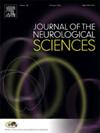Mortality and prognosis in herpes simplex Virus-1 encephalitis long-term follow up study
IF 3.6
3区 医学
Q1 CLINICAL NEUROLOGY
引用次数: 0
Abstract
Background and objectives
Herpes simplex virus-1 (HSV-1) encephalitis is the most prevalent form of viral encephalitis worldwide. Consensus statements on the rate of mortality are lacking, with most studies emphasizing short-term mortality risks
. We aimed to describe variables effecting mortality for HSV-1 encephalitis in a long term well defined HSV cohorts.
Methods
This is a retrospective study, encephalitis patients who were HSV-positive (HSV- 1,HSV-2 and VZV) in the cerebrospinal fluid (CSF) in 23 years' time frame were compared. Clinical, electrophysiological, imaging, and laboratory data were analyzed.
Results
We identified 47 HSV-1, 8 HSV-2 and 216 with VZV patients with a molecular CSF PCR diagnosis. The median age at diagnosis was 63.3 (interquartile range(IQR) 50.42–72.52) for HSV-1, 46.79 (IQR 36.55–55.05) for HSV-2 and 60.33.
(IQR 33.78–74.11) for VZV (p = 0.14). The mean follow up time was 6.25 ± 5.92 years for the group as whole. Among HSV-1 patients, during the follow-up period, 26 patients (55.31 %) died. Ten deaths occurred within the first year, with a median age of death of 70.6 [63.53–75.39]. Patients who died were older (70.6 [63.53–75.39 vs.
48.59 [37.88–61.71], p < 0.001), had a longer time to treatment initiation (4.01 ± 5.69 vs. 1.96 ± 3.58 days, p = 0.026), with cancer comorbidities more prevalent (42.3 % vs. 0 %, p < 0.001). Univariate analysis showed older age (HR 1.07, 95 % CI 1.03–1.10, p < 0.01), and cancer comorbidity (HR 5.55, 95 % CI 2.31–13.33, p < 0.001) were associated with significantly higher risk for mortality. Multivariate analysis confirmed that older age (HR 1.096, 95 % CI 1.04–1.15, p < 0.001), cancer comorbidity (HR 11.02, 95 % CI 2.76–43.9, p < 0.001) and lower lymphocyte count (HR 0.97, 95 % CI 0.95–0.99, p = 0.032) influenced mortality risk. The optimal cut-off age to predict mortality based on AUC-ROC curve was 63.29 (AUC = 0.83, sensitivity = 0.76, specificity = 0.80, PPV = 0.83, NNV = 0.73, p < 0.001). Patients above this age cutoff had a significantly greater cumulative incidence of mortality than did those aged 50–63 years (p < 0.01).
Discussion
Mortality due to HSV-1 was high and highest in patients >63 years or immunocompromised patients. Favorable outcomes were associated with increased lymphocyte levels in CSF, and early antiviral treatment. These finding may help explain the wide discrepancies in reported mortality rates for HSV encephalitis patients.
单纯疱疹病毒-1型脑炎的死亡率和预后的长期随访研究
背景与目的单纯疱疹病毒1型(HSV-1)脑炎是世界范围内最常见的病毒性脑炎。缺乏关于死亡率的共识声明,大多数研究强调短期死亡风险。我们的目的是描述在长期定义明确的HSV队列中影响HSV-1脑炎死亡率的变量。方法对23年脑脊液中HSV阳性(HSV- 1、HSV-2和VZV)的脑炎患者进行回顾性研究。对临床、电生理、影像学和实验室数据进行分析。结果经分子脑脊液PCR诊断为1型单纯疱疹病毒47例,2型单纯疱疹病毒8例,伴有VZV病毒216例。HSV-1、HSV-2和HSV-2的中位诊断年龄分别为63.3岁(四分位数间距(IQR) 50.42 ~ 72.52)、46.79岁(IQR 36.55 ~ 55.05)和60.33岁。(IQR 33.78-74.11) (p = 0.14)。全组平均随访时间为6.25±5.92年。1型单纯疱疹患者随访期间死亡26例(55.31%)。1年内死亡10例,死亡年龄中位数为70.6岁[63.53-75.39]。死亡患者年龄较大(70.6 [63.53-75.39]vs.48.59 [37.88-61.71], p <;0.001),开始治疗时间较长(4.01±5.69天对1.96±3.58天,p = 0.026),癌症合并症更普遍(42.3%对0%,p <;0.001)。单因素分析显示年龄较大(HR 1.07, 95% CI 1.03-1.10, p <;0.01)和癌症合并症(HR 5.55, 95% CI 2.31-13.33, p <;0.001)与死亡风险显著增高相关。多因素分析证实年龄较大(HR 1.096, 95% CI 1.04-1.15, p <;0.001),癌症合并症(HR 11.02, 95% CI 2.76-43.9, p <;0.001)和较低的淋巴细胞计数(HR 0.97, 95% CI 0.95-0.99, p = 0.032)影响死亡风险。AUC- roc曲线预测死亡率的最佳截止年龄为63.29岁(AUC = 0.83,敏感性= 0.76,特异性= 0.80,PPV = 0.83, NNV = 0.73, p <;0.001)。超过这一年龄界限的患者的累积死亡率明显高于50-63岁的患者(p <;0.01)。单纯疱疹病毒1型的死亡率很高,在63岁或免疫功能低下的患者中死亡率最高。良好的结果与脑脊液淋巴细胞水平升高和早期抗病毒治疗相关。这些发现可能有助于解释报道的HSV脑炎患者死亡率的巨大差异。
本文章由计算机程序翻译,如有差异,请以英文原文为准。
求助全文
约1分钟内获得全文
求助全文
来源期刊

Journal of the Neurological Sciences
医学-临床神经学
CiteScore
7.60
自引率
2.30%
发文量
313
审稿时长
22 days
期刊介绍:
The Journal of the Neurological Sciences provides a medium for the prompt publication of original articles in neurology and neuroscience from around the world. JNS places special emphasis on articles that: 1) provide guidance to clinicians around the world (Best Practices, Global Neurology); 2) report cutting-edge science related to neurology (Basic and Translational Sciences); 3) educate readers about relevant and practical clinical outcomes in neurology (Outcomes Research); and 4) summarize or editorialize the current state of the literature (Reviews, Commentaries, and Editorials).
JNS accepts most types of manuscripts for consideration including original research papers, short communications, reviews, book reviews, letters to the Editor, opinions and editorials. Topics considered will be from neurology-related fields that are of interest to practicing physicians around the world. Examples include neuromuscular diseases, demyelination, atrophies, dementia, neoplasms, infections, epilepsies, disturbances of consciousness, stroke and cerebral circulation, growth and development, plasticity and intermediary metabolism.
 求助内容:
求助内容: 应助结果提醒方式:
应助结果提醒方式:


